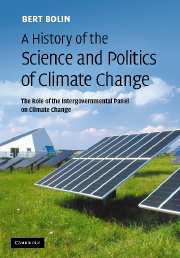 A History of the Science and Politics of Climate Change
A History of the Science and Politics of Climate Change Published online by Cambridge University Press: 03 May 2010
Combating climate change implies resolving the controversial issue of how to renew the global energy supply system, and simultaneously reduce emissions of greenhouse gases to the atmosphere.
Delayed action in spite of trustworthy scientific assessments
Mitigating climate change is finding ways and means to reduce emissions to the atmosphere and to enhance sinks for the atmospheric components that disturb the radiative balance of the earth with space. But it is equally important that this should be done in a way that minimises costs and the degree of disturbance to countries and people, ensures a sustainable development and is in this sense politically acceptable. The issue is thus not primarily a technical and economical one, but societal and political, even though technical and economic analyses of the means to deal with it are very important as a basis for identifying and reaching agreements on action plans and how they are to be implemented. A brief overview of matters that are of prime concern in this context will be given in this concluding chapter, especially with regard to the basic scientific and technical knowledge about the global society that will be required. The best common understanding of this issue is a prerequisite in order to mitigate a human-induced climate change quickly enough. This is, however, not the place to analyse the technically complex issue of alternative future global energy systems in detail.
Stabilising the global climate must necessarily be a worldwide cooperative undertaking, but it is important to recognise countries' differing ability to contribute. This is well expressed in the Climate Convention.
Article 3
1 … the Parties should protect the climate system for the benefit of present and future generations of humankind, on the basis of equity and in accordance with their common but differentiated responsibilities and respective capabilities.[…]
To save this book to your Kindle, first ensure no-reply@cambridge.org is added to your Approved Personal Document E-mail List under your Personal Document Settings on the Manage Your Content and Devices page of your Amazon account. Then enter the ‘name’ part of your Kindle email address below. Find out more about saving to your Kindle.
Note you can select to save to either the @free.kindle.com or @kindle.com variations. ‘@free.kindle.com’ emails are free but can only be saved to your device when it is connected to wi-fi. ‘@kindle.com’ emails can be delivered even when you are not connected to wi-fi, but note that service fees apply.
Find out more about the Kindle Personal Document Service.
To save content items to your account, please confirm that you agree to abide by our usage policies. If this is the first time you use this feature, you will be asked to authorise Cambridge Core to connect with your account. Find out more about saving content to Dropbox.
To save content items to your account, please confirm that you agree to abide by our usage policies. If this is the first time you use this feature, you will be asked to authorise Cambridge Core to connect with your account. Find out more about saving content to Google Drive.